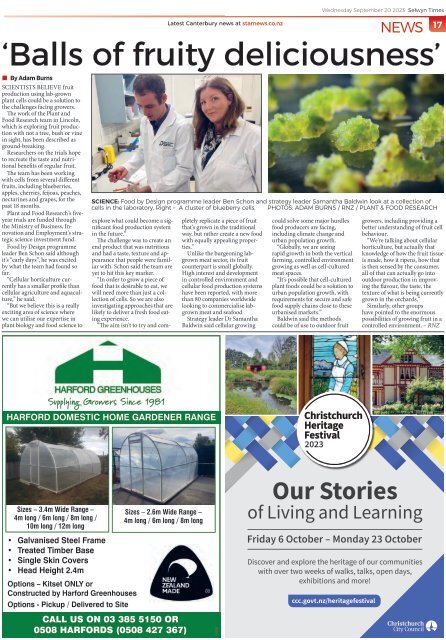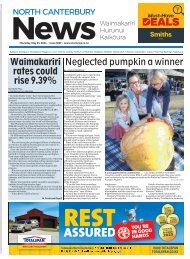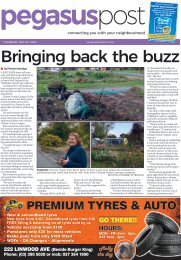Create successful ePaper yourself
Turn your PDF publications into a flip-book with our unique Google optimized e-Paper software.
Wednesday <strong>September</strong> <strong>20</strong> <strong>20</strong>23 <strong>Selwyn</strong> <strong>Times</strong><br />
Latest Canterbury news at starnews.co.nz<br />
NEWS 17<br />
‘Balls of fruity deliciousness’<br />
• By Adam Burns<br />
SCIENTISTS BELIEVE fruit<br />
production using lab-grown<br />
plant cells could be a solution to<br />
the challenges facing growers.<br />
The work of the Plant and<br />
Food Research team in Lincoln,<br />
which is exploring fruit production<br />
with not a tree, bush or vine<br />
in sight, has been described as<br />
ground-breaking.<br />
Researchers on the trials hope<br />
to recreate the taste and nutritional<br />
benefits of regular fruit.<br />
The team has been working<br />
with cells from several different<br />
fruits, including blueberries,<br />
apples, cherries, feijoas, peaches,<br />
nectarines and grapes, for the<br />
past 18 months.<br />
Plant and Food Research’s fiveyear<br />
trials are funded through<br />
the Ministry of Business, Innovation<br />
and Employment’s strategic<br />
science investment fund.<br />
Food by Design programme<br />
leader Ben Schon said although<br />
it’s “early days”, he was excited<br />
by what the team had found so<br />
far.<br />
“Cellular horticulture currently<br />
has a smaller profile than<br />
cellular agriculture and aquaculture,”<br />
he said.<br />
“But we believe this is a really<br />
exciting area of science where<br />
we can utilise our expertise in<br />
plant biology and food science to<br />
SCIENCE: Food by Design programme leader Ben Schon and strategy leader Samantha Baldwin look at a collection of<br />
cells in the laboratory. Right – A cluster of blueberry cells. PHOTOS: ADAM BURNS / RNZ / PLANT & FOOD RESEARCH<br />
explore what could become a significant<br />
food production system<br />
in the future.”<br />
The challenge was to create an<br />
end product that was nutritious<br />
and had a taste, texture and appearance<br />
that people were familiar<br />
with. Schon said the team are<br />
yet to hit this key marker.<br />
“In order to grow a piece of<br />
food that is desirable to eat, we<br />
will need more than just a collection<br />
of cells. So we are also<br />
investigating approaches that are<br />
likely to deliver a fresh food eating<br />
experience.<br />
“The aim isn’t to try and completely<br />
replicate a piece of fruit<br />
that’s grown in the traditional<br />
way, but rather create a new food<br />
with equally appealing properties.”<br />
Unlike the burgeoning labgrown<br />
meat sector, its fruit<br />
counterpart is small globally.<br />
High interest and development<br />
in controlled environment and<br />
cellular food production systems<br />
have been reported, with more<br />
than 80 companies worldwide<br />
looking to commercialise labgrown<br />
meat and seafood<br />
Strategy leader Dr Samantha<br />
Baldwin said cellular growing<br />
could solve some major hurdles<br />
food producers are facing,<br />
including climate change and<br />
urban population growth.<br />
“Globally, we are seeing<br />
rapid growth in both the vertical<br />
farming, controlled environment<br />
growing as well as cell-cultured<br />
meat spaces.<br />
“It’s possible that cell-cultured<br />
plant foods could be a solution to<br />
urban population growth, with<br />
requirements for secure and safe<br />
food supply chains close to these<br />
urbanised markets.”<br />
Baldwin said the methods<br />
could be of use to outdoor fruit<br />
growers, including providing a<br />
better understanding of fruit cell<br />
behaviour.<br />
“We’re talking about cellular<br />
horticulture, but actually that<br />
knowledge of how the fruit tissue<br />
is made, how it ripens, how that<br />
is then sensed by the consumer,<br />
all of that can actually go into<br />
outdoor production in improving<br />
the flavour, the taste, the<br />
texture of what is being currently<br />
grown in the orchards.”<br />
Similarly, other groups<br />
have pointed to the enormous<br />
possibilities of growing fruit in a<br />
controlled environment. – RNZ<br />
Supplying Growers Since 1981<br />
HARFORD DOMESTIC HOME GARDENER RANGE<br />
<strong>20</strong>23<br />
Sizes – 3.4m Wide Range –<br />
4m long / 6m long / 8m long /<br />
10m long / 12m long<br />
• Galvanised Steel Frame<br />
• Treated Timber Base<br />
• Single Skin Covers<br />
• Head Height 2.4m<br />
Options – Kitset ONLY or<br />
Constructed by Harford Greenhouses<br />
Options - Pickup / Delivered to Site<br />
Sizes – 2.6m Wide Range –<br />
4m long / 6m long / 8m long<br />
CALL US ON 03 385 5150 OR<br />
0508 HARFORDS (0508 427 367)<br />
2566341a<br />
Our Stories<br />
of Living and Learning<br />
Discover and explore the heritage of our communities<br />
with over two weeks of walks, talks, open days,<br />
exhibitions and more!<br />
ccc.govt.nz/heritagefestival


















